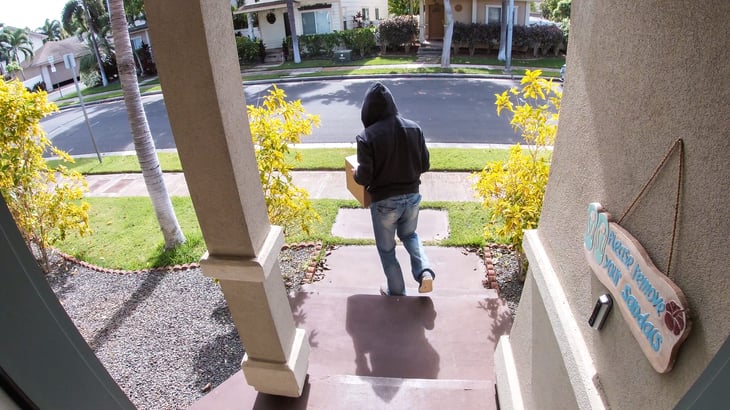
Editor's Note: This story originally appeared on Forbes Advisor.
These days, you can get almost anything delivered to your door, from clothing and groceries to medication and pet supplies, and it’s a modern convenience that all consumers greatly appreciate.
Whether it’s several packages from an Amazon shopping spree or you went a little overboard on Etsy, coming home to your new item is a happy experience. Unfortunately, it’s also a happy day for porch pirates scoping out your daily haul.
A porch pirate is someone who preys on parcels delivered to a home and steals them from the porch or front doorstep.
These thieves can strike in any area or neighborhood at any time and target all sizes of packages. They steal packages hoping they may contain valuable items they can sell, such as computers and gaming consoles.
Here is a breakdown of the worst states for porch pirates.
The Worst States for Porch Pirates

Porch pirates strike regardless of the environment, climate or economics of the area. They stake out their target and attack and sometimes repeatedly. But, some states are plagued by porch pirates more than others.
- According to Wakefield Research, 34% of porch piracy takes place in cities, 20% in suburban areas, and 10% in rural areas.
- Larceny is the theft of personal property belonging to someone else. We took a look at larceny rates in relation to population as well as which states are googling “package stolen” and other similar keywords to rank states with the most commonly reported packages stolen.
1. New Hampshire

- Population (U.S. Census 2021): 1,388,992
- Larceny per 100,000: 158.39
- Larceny prevalence rank: 6
- Google searches per 100,000: 60.48
- Google search rank: 1
- Weighted Score: 4.25
- Scaled Score (0-100): 100
2. Oklahoma

- Population (U.S. Census 2021): 3,986,639
- Larceny per 100,000: 167.56
- Larceny prevalence rank: 5
- Google searches per 100,000: 17.96
- Google search rank: 7
- Weighted Score: 5.7
- Scaled Score (0-100): 96.66
3. Delaware

- Population (U.S. Census 2021): 1,003,384
- Larceny per 100,000: 341.15
- Larceny prevalence rank: 1
- Google searches per 100,000: 12.39
- Google search rank: 21
- Weighted Score: 8
- Scaled Score (0-100): 91.35
4. Iowa

- Population (U.S. Census 2021): 3,193,079
- Larceny per 100,000: 138.64
- Larceny prevalence rank: 10
- Google searches per 100,000: 19.7
- Google search rank: 6
- Weighted Score: 8.6
- Scaled Score (0-100): 89.97
5. Colorado

- Population (U.S. Census 2021): 5,812,069
- Larceny per 100,000: 146.73
- Larceny prevalence rank: 9
- Google searches per 100,000: 17.77
- Google search rank: 8
- Weighted Score: 8.65
- Scaled Score (0-100): 89.85
6. Kansas

- Population (U.S. Census 2021): 2,934,582
- Larceny per 100,000: 106.59
- Larceny prevalence rank: 16
- Google searches per 100,000: 30.63
- Google search rank: 3
- Weighted Score: 11.45
- Scaled Score (0-100): 83.39
7. Washington

- Population (U.S. Census 2021): 7,738,692
- Larceny per 100,000: 113.39
- Larceny prevalence rank: 14
- Google searches per 100,000: 17.68
- Google search rank: 9
- Weighted Score: 12.25
- Scaled Score (0-100): 81.55
8. Oregon

- Population (U.S. Census 2021): 4,246,155
- Larceny per 100,000: 129.32
- Larceny prevalence rank: 11
- Google searches per 100,000: 13.49
- Google search rank: 16
- Weighted Score: 12.75
- Scaled Score (0-100): 80.39
9. Minnesota

- Population (U.S. Census 2021): 5,707,390
- Larceny per 100,000: 319.25
- Larceny prevalence rank: 2
- Google searches per 100,000: 9.88
- Google search rank: 36
- Weighted Score: 13.9
- Scaled Score (0-100): 77.74
10. Missouri

- Population (U.S. Census 2021): 6,168,187
- Larceny per 100,000: 168.14
- Larceny prevalence rank: 4
- Google searches per 100,000: 10.94
- Google search rank: 33
- Weighted Score: 14.15
- Scaled Score (0-100): 77.16
11. Tennessee

- Population (U.S. Census 2021): 6,975,218
- Larceny per 100,000: 224.08
- Larceny prevalence rank: 3
- Google searches per 100,000: 7.31
- Google search rank: 40
- Weighted Score: 15.95
- Scaled Score (0-100): 73.01
12. Arkansas

- Population (U.S. Census 2021): 3,025,891
- Larceny per 100,000: 151.06
- Larceny prevalence rank: 8
- Google searches per 100,000: 11.7
- Google search rank: 32
- Weighted Score: 16.4
- Scaled Score (0-100): 71.97
13. Massachusetts

- Population (U.S. Census 2021): 6,984,723
- Larceny per 100,000: 101.59
- Larceny prevalence rank: 18
- Google searches per 100,000: 13.72
- Google search rank: 15
- Weighted Score: 16.95
- Scaled Score (0-100): 70.7
14. Alabama

- Population (U.S. Census 2021): 5,039,877
- Larceny per 100,000: 151.35
- Larceny prevalence rank: 7
- Google searches per 100,000: 8.45
- Google search rank: 38
- Weighted Score: 17.85
- Scaled Score (0-100): 68.63
15. Rhode Island

- Population (U.S. Census 2021): 1,095,610
- Larceny per 100,000: 78.13
- Larceny prevalence rank: 29
- Google searches per 100,000: 40.16
- Google search rank: 2
- Weighted Score: 19.55
- Scaled Score (0-100): 64.71
Methodology

To determine the states with the highest package theft rates, Forbes Advisor used property crime data from the FBI’s Crime Database Explorer, which included statistics as recent as 2021. We queried the FBI database for each state’s figures for “larceny from a building,” which corresponds to package theft.
FBI data relies on self-reported local, county, tribal area, and state figures. This means there could be potential undercounts of the numbers of cases involving larceny from a building if that state or its local law enforcement departments did not report those numbers to federal authorities.
We then took the sum of each state’s local, county, tribal, and state law enforcement figures presented in the FBI data to come to a statewide total for larceny from building incidents in 2021. Finally, to control for varying state population sizes, we scaled the number to include the number of incidents per 100,000 residents.
Forbes Advisor also used Google Analytics to track total searches over the past 12 months in each state for keywords including “package theft,” “package thief,” “stolen package,” “stolen delivery” and other similar phrases. Again, we controlled for the state population by converting the figures to show the number of searches for every 100,000 residents in the state.
Population data used in both FBI and Google Search calculations was collected from the 2021 U.S. Census. Crime incidence and search intensity data were then weighted to create our final scores and rankings.





Add a Comment
Our Policy: We welcome relevant and respectful comments in order to foster healthy and informative discussions. All other comments may be removed. Comments with links are automatically held for moderation.